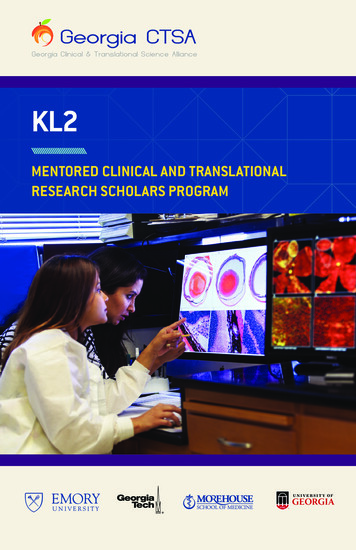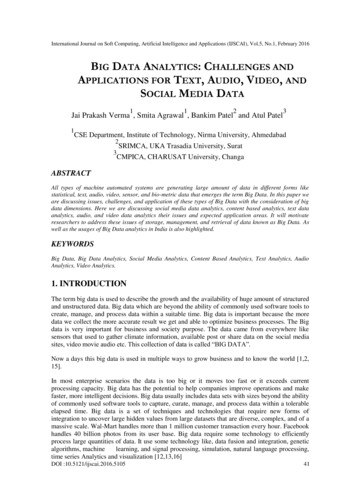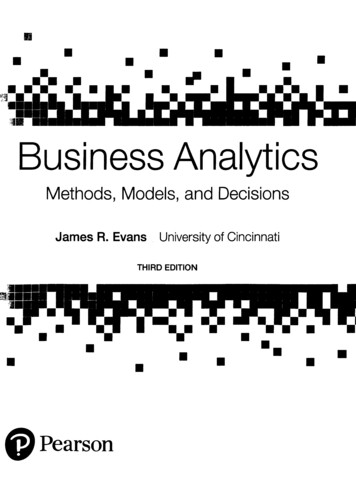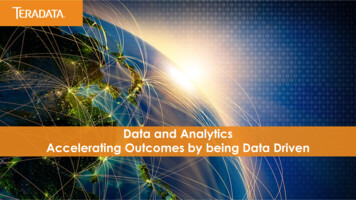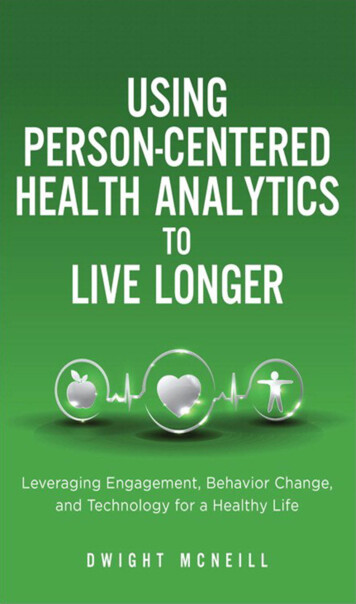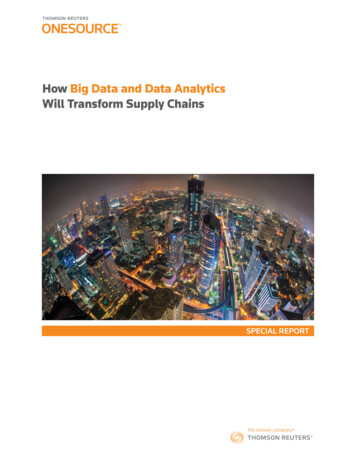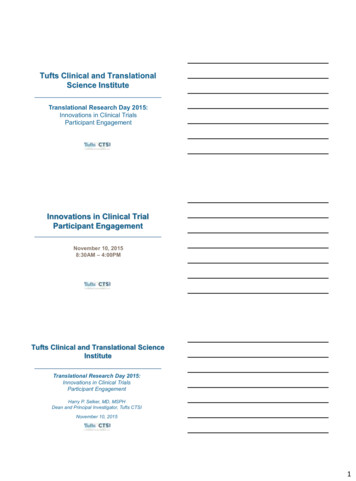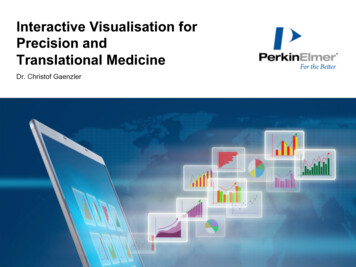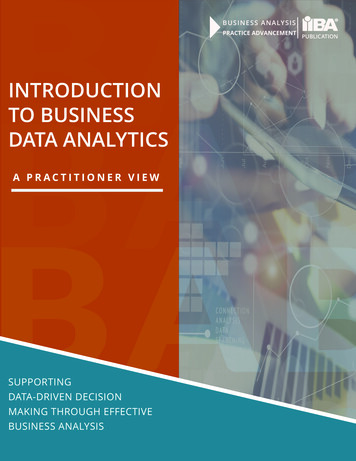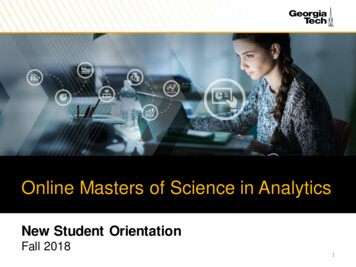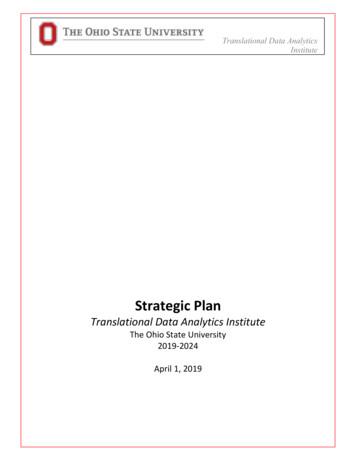
Transcription
Translational Data AnalyticsInstituteStrategic PlanTranslational Data Analytics InstituteThe Ohio State University2019-2024April 1, 2019
The Ohio State UniversityVISIONThe Ohio State University is the model 21st-century public, land grant, research, urban, community engaged institution.MISSIONThe University is dedicated to: Creating and discovering knowledge to improve the well-being of our state, regional, national and global communities;Educating students through a comprehensive array of distinguished academic programs;Preparing a diverse student body to be leaders and engaged citizens;Fostering a culture of engagement and service.We understand that diversity and inclusion are essential components of our excellence.VALUESShared values are the commitments made by the University community in how we conduct our work. At TheOhio State University we value: ExcellenceDiversity in people and of ideasInclusionAccess and affordabilityInnovationCollaboration and multidisciplinary endeavorIntegrity, transparency, and trustCORE GOALSFour institution-wide goals are fundamental to the University’s vision, mission and future success:Teaching and Learning: to provide an unsurpassed, student-centered learning experience led by engaged worldclass faculty and staff and enhanced by a globally diverse student body.Research and Innovation: to create distinctive and internationally recognized contributions to the advancement offundamental knowledge and scholarship and toward solutions of the world’s most pressing problems.Outreach and Engagement: to advance a culture of engagement and collaboration involving the exchange ofknowledge and resources in a context of reciprocity with the citizens and institutions of Ohio, the nation, and theworld.Resource Stewardship: to be an affordable public university, recognized for financial sustainability, unparalleledmanagement of human and physical resources, and operational efficiency and effectiveness.What Ohio State does matters. Our responsibility over the next 150 years is to be a fixedbeacon to illuminate the path to the American dream and address the most pressing issuesof our times. Ohio State’s Strategic Plan - Time and Change (2017)Page i
Strategic PlanTranslational Data AnalyticsInstituteTable of ContentsLetter from Interim Faculty Director . 1I. TDAI Overview . 2II. Strategic Scan . 5III. Succeeding in Our Mission . 9A. Research and Innovation.10B. Teaching and Learning. .16C. Outreach and Engagement.19D. Resource Stewardship.21IV. Financial Plan .23V. Metrics.24AppendixA. TDAI Faculty Affiliates/Membership . .32B. Status Reports (2017, 2018) . . .34C. Communities-of-Practice Plans . . . . .38D. Capture Plans, Proposals and Awards . .46Page ii
Letter from the Interim Faculty DirectorDear Colleagues,Over the last four-and-half years, the Translational Data Analytics Institute (TDAI) - thelargest and most cross-cutting Discovery Theme on OSU’s campus - has set and shaped its owninstitutional priorities to promote interdisciplinary research, advance academic innovation, andfoster robust external partnerships that bring value to our faculty and students. Within the Instituteitself, it is successfully creating an organizational backbone in the form of four faculty communitiesof practice in disparate domains, garnering significant grants in areas of strategic importance,planning the launch of an innovative Professional Science Master’s degree program, and establishingfoundational corporate partners for the Institute. Further, TDAI has established a national presenceby leading and participating in forums that explore the roles of data science centers in academia andin the larger community.It was only two years that the Translational Data Analytics initiative became an Instituteconsolidating its position on campus and establishing itself as a prominent center of data scienceresearch and scholarship. The Institute was still in its infancy then. Now during this phase of growth,what is required is a strong and clear sense of identity. This is indeed the path that TDAI hasembarked upon namely to create an indelible core and eventually differentiate itself from its peers.TDAI has successfully recruited more than 50 faculty in various TIUs and created the human capital itneeds to grow and sustain. It also counts more than 150 affiliated faculty who constantly contributeto ongoing activities and enrich it. It is only because of this wide network that TDAI has successfullyinitiated many of its on-going activities. What is needed imminently is an organically developedstrategic plan that is agreed upon by TDAI’s constituent community of scholars and all stakeholders.The current strategic plan is vastly different from what was presented three years ago. Thenew plan is being developed with participation by the TDAI community, including constituent facultyand all the various stakeholders. We duly noted the aspirations of the TDAI community in thestrategic plan. Further, it also rests on a highly objective assessment of our strengths andweaknesses. While it is TDAI’s goal to view this document as organic and evolving, it will also serveas a blueprint and guardrails for TDAI to achieve the heights it aspires to scale, namely, to be anational top five institute of data science and to serve the Ohio State community well.I thank the TDAI community, the Office of Academic Affairs and the Office of Research forgiving me the opportunity to lead TDAI for the last 3 years. It has been an honor to represent thedata science community on our campus and grow TDAI into a functioning entity. I will be steppingdown from my role by the end of the 2019 Academic year. I only wish the most success to the newleadership when it takes the helm of TDAI.Sincerely,Raghu Machiraju, PhDProfessorBioMedical Informatics and Computer Science and EngineeringPage 1
I. TDAI OverviewHistoryOhio State released an internal request for proposals in data analytics in September 2013 asan inaugural step in the Discovery Themes initiative. A faculty-led group combined 49 proposalsinto a single “Data Analytics Framework” document released in February 2014. The Data AnalyticsCollaborative (DAC) Framework identified the university’s existing strengths and recommendedhiring 100 new faculty leveraging our strengths in data analytics foundations (computer science,mathematics, and statistics) and applied domains of health and well-being, climate andenvironment, and complex systems and network science. That recommendation precipitatedfaculty recruitment across Ohio State dedicated to the growth of data science and analytics (DSA).In January 2015 version 1.0 of a program plan for the DAC was issued, and the term translationalwas used in our vision and mission statements. Translational data analytics is defined as“application of data analytics theories and methods to generate solutions for real world problems .in consultation with stakeholders.” In March 2015, the DAC was renamed Translational DataAnalytics (TDA) and version 2.0 of a program plan was issued. In April 2017, the University Senateapproved the Translational Data Analytics Institute (TDAI) as a university-level institute. At thattime, the Institute reported to the Executive Vice President and Provost, Office of Academic Affairs,befitting its reach across the university and the expectation that TDAI integrate and make accessibleas possible all university data assets and expertise. Following an external review in January 2018,the Institute was repositioned under the Office of Research (OR), reporting to the Vice President forResearch and Senior Associate Vice President for Research.Vision, Mission & GoalsVISIONMISSIONTo establish the state of Ohio as a global hub for development, application and study oftranslational data analytics solutions.To create and apply data analytics solutions to issues of global importance in partnership withthe external community, while advancing foundational data science theories and methods.As part of our on-going strategic planning process, the vision, mission and goals of TDAIwere made available for comment to TDAI faculty and other stakeholders at the university, as wellas external reviewers. The current goals are included in Succeeding in Our Mission (Section III). Itshould be noted that faculty affiliates informed the content of this Strategic Plan via insights andfeedback gathered at a TDAI faculty affiliate Town Hall (January 2019), Communities-of-Practicemeetings (described below), and a Strategic Planning Retreat (March 2019). Below we highlightvalue propositions and programs for the various communities that the Institute serves.Value propositionsWe have developed several value propositions for the various community segments that theInstitute serves. Below we provide an overarching value proposition and value propositions forthree specific segments.Page 2
Overarching Value Proposition: First and foremost, TDAI will define data science and analytics as itwill be practiced on campus with a strong focus on specific research themes and their manifestationin educational offerings and extensive outreach. For internal and external communities that needDSA integration, TDAI serves as a central hub for faculty, students and staff working in foundationaland applied DSA and connects them with industry/external sponsors, each other, and resources fortranslational team research and workforce development, unlike fractionated DSA resources acrossthe university. We do this by the programs and events we design and implement, the research andacademic programming we support, and the space we provide.Value Propositions for Specific Segments: For faculty affiliates that need opportunities for data science scholarship that are difficult topursue on their own, TDAI's centralized resources and services support their efforts in teamscience through funding and collaborators for advancement of knowledge and societal impact,unlike resources at the department or college levels. We do this by creating robustcommunities of researchers (e.g., hiring faculty, supporting all faculty affiliates, co-locatingteams); pursuing extramural funding in a strategic and focused manner to support teamscholarship (e.g., seed grants, proposal development support, communities-of-practice (CoPs));and leveraging external partnerships (e.g., foundational industry partners, federal and stategovernment agencies, universities), to name a few. For students that need training and jobs in DSA, TDAI provides a centralized hub for skills-basedprograms, experiential learning opportunities, and access to employers unlike internal/externalopportunities that students would navigate themselves. We do this by sharing the OSU DSAcourse directory, connect them to recruiting opportunities, create degrees and certificates,provide access to professional development tools, hold challenges and events, and providespace (labs, office, proximity to major) in state-of-the-art facilities. For industry partners that need a workforce pipeline, training for existing workforce, visibility,and R&D in the DSA arena, TDAI provides access to students and faculty experts, as well as tools,resources and team science opportunities unlike large research universities in the US that lack acentralized DSA Institute. We do this by academic programming, grant proposal development,product testing, recruitment opportunities and access to lab rental and event space.Institute MembershipTDAI was one of the first Discovery Themes to hire new faculty beginning in 2016. Today, 53faculty have been hired and join other experts to form the 150 TDAI faculty affiliate communityspanning nearly every college, Nationwide Children’s Hospital, the Wexner Medical Center, and tworegional campuses (Appendix B). The Institute does not currently have formal membership forstudents and other trainees, but plans to add student/trainee membership in near future.Programs OfferedProgrammatic activities are aligned with institute goals in areas of research, education andoutreach, and are summarized in the graphic below (Figure 1). To date, there are numerousprograms that TDAI has launched, and details of these programs are discussed in Succeeding in OurMission (see Section III). The TDAI community is further bolstered through strategic partnershipsdesigned to leverage and elevate – in addition to creating completely new – DSA programming. Thisincludes a Researcher Exchange program with Nagoya University, co-sponsored trainings andlectures with 15 university centers / offices, a data science summer camp for 8-10th grade women,Page 3
and the programming of a 21,000 square feet of state-of-the-art innovation space and dataanalytics hub in Pomerene Hall.Figure 1. Programmatic supported by the Institute.Points of PrideSucceeding in Our Mission (Section III) cites key outcomes realized by TDAI while weimplemented the TDA Program Plan V2.0. Our 2017 and 2018 Progress Reports (Appendix B) ourFY18 Annual Report and a Business Model Canvas (Figure 2 below) also provide additional contextwhich, combined with the information presented under the Strategic Scan (Section II), lay thegroundwork for setting 2019-2024 goals and tactics.Page 4
Figure 2. Business Model Canvas for the Institute.Page 5
II. Strategic ScanSocietal Issues & ImpactOhio State is fully investing in the power of data science through the Translational DataAnalytics Institute. TDAI provides an overarching structure and framework to strengthen and growour intellectual community at Ohio State. Faculty affiliates conduct research in foundational datasciences, as well as in applied areas, both of which may develop data-driven solutions to discovernew drugs, improve crop yields, increase manufacturing efficiencies, respond to natural disasters,reduce chronic disease impacts, and address complex and devastating societal challenges, such asinfant mortality and opioid addiction – collectively generating big data for good! The Institute is alsocommitted to the land grant mission of the university, through dissemination of knowledge tointernal and external communities that it serves.SWOT AnalysisSince 2016 we have continued to assess Ohio State’s strengths in DSA that can be leveragedby the Institute, as well as weaknesses that the Institute should address and/or mitigate goingforward. In addition, we conducted a competitive landscape analysis of several US universities withDSA institutes, using the report of the Spring 2018 Data Science Summit 1 and the December 2018Moore and Sloan Foundations report as a guide 2. Here, we analyzed unique university programs andexternal trends (threats) and noted areas in which potential competitors were noticeably absent ornew external trends in data analytics emerged (opportunities) (Table 1). The resulting SWOT analysishas informed our strategic approach that follows (see Section III. Succeeding in Our Mission.)INTERNAL SCAN - Strengths1. Translational Focus. Most of our peer institutions choose to focus on either the foundationalapplication of DSA or specific domains within it. Ohio State’s focus on translational dataanalytics is unique, encompassing both rigorous quantitative and computational techniques,as well as critical implementation issues such as human factors, policy level evaluation, andsocio-cultural analyses. TDAI has thus created a crucible whereby abstract theories of datatopology and structure informs practice of material science and engineering and networkscience as applied to social problems.2. Breadth of Scholarship. As described earlier, the Institute membership consists of 150 faculty affiliates across 13 of the university’s 15 colleges and representing 45 tenure-initiatingunits (TIUs) and an equivalent number of disciplines.3. National Reputation. In addition to the national and international recognition of ourindividual faculty, the Institute itself is also gaining national recognition. For instance, TDAI cohosted with the National Science Foundation (NSF) two national workshops devoted totranslational data science, contributed to collaborative white papers, and became a BIGDATASpoke to the Midwest BIGDATA Hub at University of Illinois, Urbana-Champaign. In addition,the Business Higher Education Forum’s (BHEF) white paper with PricewaterhouseCooperscited TDAI for its industry-informed academic programming. 34. Data Assets. As will be described in Succeeding in Our Mission (Section III), TDAI is building aData Commons to support collaborative, interdisciplinary research and education, and toData Science Summit report http://tinyurl.com/2018SpringDataSummitAcademic Data Science Centers in the United States: A Study of 20 Universities. Greenberg, Mentzel, Katz; December 2018.3Investing in America’s Data Science and Analytics Talent: The Case for Action. pwc.com/us/dsa-skills; April 2017.12Page 6
facilitate access to unique datasets. It is also creating programs which will use both its physicalspace (Pomerene Hall) and the greater campus to collect data for more analysis andscholarship. Our collaboration with Hewlett-Packard Enterprise/Aruba Networks is a case inpoint.5. Dedicated Discovery Space. The recent renovation of Pomerene Hall provides the Institutewith more than 20,000 square feet of discovery space designed to promote interdisciplinary,collaborative, team-based research and education initiatives. The spaces also support theintegration of industry and the larger community as long-term partners in technology,research, and education.6. Industry-driven Talent Solutions. TDAI’s approach to talent – both through a ProfessionalScience Master’s degree (PSM) and in skill-based certificates – is being created by closeconsultation with industry, government, and non-profit organizations, identifying educationalgaps and unmet talent opportunities in translational data analytics.7. Strong University Commitment and Alignment. The University’s commitment to the Instituteis evidenced by the hiring of 53 new faculty, a 21,000-sq-ft data building, and support forresearch, education and outreach programs. There is commitment by Office of Research topartner with TDAI and all Discovery Themes to build appropriate sustainability plans. Further,the research agenda of TDAI is aligned with the broad dictates and directions set by the Officeof Research.INTERNAL SCAN - Weaknesses1. Breadth of Scholarship. The breadth and depth of scholarship in which our faculty engage is avery powerful asset for interdisciplinary research and scholarship – encompassing 45disciplines (illustrated in Appendix B). Further, many of the recruited faculty are of junior rank(assistant professors), thus creating a bench with little depth or seniority. Further, there arefew mechanisms for TDAI to exert influence as TIUs can. The Faculty Lead does not have atenure vote. While this interdisciplinarity and breadth is commendable, engaging such a largecontingent of faculty affiliates – who may not naturally engage in team scholarship for all theabove reasons– remains TDAI’s most significant challenge. How do we better engage facultyaffiliates in meaningful, valuable and impactful ways?2. Difficulty Recruiting a Diverse Faculty. Of TDAI’s 53 newly hired faculty, we have recruited 17women and 23 underrepresented minorities. Of our total faculty membership, roughly 32%are women and 43% are underrepresented minorities. (Note: Numbers are self-reported toOAA.) It should be noted that the BHEF-PWC report mentioned earlier noted that recruitmentof women and underrepresented minorities in data science is a systemic issue nationwide.Still, when TDAI became an Institute a pledge was made to address this issue by proactivehiring and also by leveraging other resources on campus, even though there was a tacitagreement that the lack of diversity was an institutional problem (and not just that of a singleinstitute). In that spirit, TDAI believes more can and should be done on this front.3. Untested Financial Sustainability Plan. Under the Discovery Themes program, the nowInstitute was seeded with a substantial university investment to hire faculty and run selectprograms. Via this mechanism, a portion of facilities and administrative (F&A) costs fromextramural funding secured by TDA faculty hires currently flows to OAA. A committee wasrecently formed by university administration to address distribution and use of these fundsgoing forward. While waiting for more specificity in that plan, TDAI is separately developing afinancial sustainability model that includes a portfolio of revenue streams not only from theabove F&A, but also from proposal development support, academic programs, skill-basedPage 7
competency training, sponsorships, event registrations, philanthropic gifts, technicalconsultations, and Pomerene rental income. Still, there are few degrees of freedom that thecurrent operational funds allow given the large expanse of the campus TDAI covers. It hasbeen difficult to incentivize faculty participation and jump start new ventures.4. Need for External Alliances. As more universities enter the field of DSA, stronginterinstitutional alliances are critical for success of DSA institutes. Recently, TDAI formed aFoundational Partnership with Aruba Networks, a subsidiary of Hewlett Packard Enterprise.This alliance is based on a philanthropic gift and investments aimed at growing thisrelationship to include sponsored research projects. It is necessary to also form alliances withFoundations and select universities.5. Difficult to Navigate and Communicate. While the breadth of expertise at the university is astrength, the increased size associated with that breadth can make the university difficult tonavigate for both internal and external parties. The Institute addresses this weakness in partby serving as a convener and integrator. Similarly, it has been a challenge to disseminateinformation and reach given TDAI’s very large footprint.EXTERNAL SCAN - Opportunities1. Need for Data Analytics-trained workforce. Businesses and industry have recognized theincreasing need for a workforce that is fluent in data analytics. To that end, it has beenestimated that by 2020 there will be 2.72 M new job postings in DSA in the US. 4 Businessesand industry also acknowledge that their current employees may require some degree of“upskilling” for the company to remain competitive.2. Need to Educate Community. With the increase in data generated from almost every facet ofour everyday lives, there is an accompanying increase in the need to educate both expert andlay individuals across disciplines on the power and limitations of data analytics.3. Need for Data Analytics to Optimize Business Processes. Many businesses and industries aregenerating vast amounts of data that, if integrated and analyzed appropriately, can beharvested to inform process improvements and future product development. Thus, there is aneed for these analyses to be conducted in-house or via outsourcing.4. Need for Data Analytics Support in State and Local Government. In recent years, the state ofOhio government agencies demonstrated increasing need for data analytics solutions. Forinstance, TDAI was pre-qualified by the Ohio Department of Administrative Services to bid on 25M in contracts to provide “data analytics expert firms, tools and methods” for State needs.As well, there are other opportunities within the State Government in collaboration with theOhio Colleges of Medicine and Government Resources Center.5. Increased Federal Funding for Data Analytics Research and Training. The National Institutesof Health (NIH) continues to emphasize the importance of data analytics, as evidenced by itsBig Data to Knowledge initiative (BD2K), the June 2018 release of its first Strategic Plan forData Science, and its creation of a new NIH position of Chief Data Strategist. Similarly, theNational Science Foundation (NSF) has invested significantly in big data research, educationand community-building for many years, as evidenced by its Computational and Data-EnabledScience and Engineering (CDS&E) program, Big Data Regional Innovation Hubs and Spokes,and the Harnessing the Data Revolution (HDR) program. Additional federal governmentagencies, including the Department of Defense (DARPA, etc.) among others, are also investingheavily in data analytics research.4Data Science and Analytics Higher Education Survey. Gallup and BHEF, December 2016.Page 8
6. Increased Industry Funding for Data Analytics Research and Training. Corporations areincreasingly looking to find partners to develop technologies and address their businesschallenges. TDAI can strategically target industry sectors (information sciences as representedby Elsevier) to seek new opportunities.Table 1. Summary of SWOT analysisSTRENGTHS1. Breadth and depth of scholarship2. National reputation3. Data Assets4. Dedicated discovery space5. Industry-driven talent solutions6. External connectionsINTERNAL SCANWEAKNESSES1. Breadth of scholarship2. Difficulty recruiting a diverse faculty3. Untested financial sustainability plan4. Need for external alliances5. Difficult to navigateEXTERNAL SCANOPPORTUNITIESTHREATS1. Need for data analytics-trained workforce1. Increasing numbers of well-funded academic2. Need to educate communityDSA institutes3. Need for data analytics to optimize business2. Increasing competition for funding supportprocesses3. Industry choice of academic partners4. Need to data analytics support in state4. Academic partnershipsgovernment5. Increased federal funding for data analyticsresearch and training6. Increased industry funding for data analyticsresearch and trainingEXTERNAL SCAN - Threats1. Increasing Numbers of Well-Funded Academic DSA Institutes. In recent years, the numberof data analytics academic programs has increased 5, as have organizing centers andinstitutes. As examples, Michigan Institute for Data Science (MIDAS) and Columbia DataScience Institute offer academic programs and serve 150-225 faculty with full-time staffs of10 . In addition, these institutes have sustained programmatic investments ( 80M-100M)and corporate partners (Fortune 500 leaders and national foundations).12. Increasing Competition for Funding Support. Extramural funding from federal and localgovernment, industry and foundations continues to be increasingly competitive, andacademic peers are investing in support for large-scale proposal development efforts.3. Industry Choice of Academic Partners. With the rise in university-based data scienceinstitutes, firms have a selection of academic partners from which to choose. For example,Siemens and State Street Corporation are partners with UC Berkeley’s Institute for DataScience. Columbia University Data Science Institute has several industry affiliates, includingAWS, Google Cloud, Adobe, Microsoft Research, GE, Johnson & Johnson, and others.4. Academic Partnerships. Several inter-institutional academic partnerships in data analyticshave been enabled by extramural funding sources. Exemplar partnerships include the NSF5Data Analytics Program Takes Off. Inside Higher Ed. leges; March 2017.Page 9
supported Midwest Big Data Hub (a partnership of the University of Michigan, Iowa StateUniversity, Indiana University, the University of North Dakota, and the University of Illinoisat Urbana-Champaign) and the Moore-Sloan Data Science Environments of UC BerkeleyInstitute for Data Science, NYU Center for Data Science and UW eScience Institute.III. Succeeding in Our MissionThe Institute strives to become a center of excellence recognized nationally andinternationally for thought leadership in data science and analytics in areas such as: foundationaldata sciences, sensing, and computational social and health sciences, among others. This high-levelgoal will be attained when the Institute: (1) achieves a significant and diverse extramural fundingportfolio for interdisciplinary and inter-institutional research and training; (2) is recognized for itsexemplar scholarship, academic programs and training, and outreach; (3) is sustainable long-term;and (4) has a measurable impact on issues of global importance. Toward this end, the Institute hasput forth four primary goals, with individual goals mapping to each university core goal area:research and innovation, teaching and learning, outreach and engagement, and resourcestewardship (Table 2). As indicated in the Letter from the Interim Faculty Director, this draftStrategic Plan has evolved from the original put forth a few years ago. That said, activities of theInstitute are consistent with the university core go
It was only two years that the Translational Data Analytics initiative became an Institute consolidating its position on campus and establishing itself as a prominent center of data science research and scholarship. The Institute was still in its infancy then. Now during this phase of growth, what is required is a strong and clear sense of .
